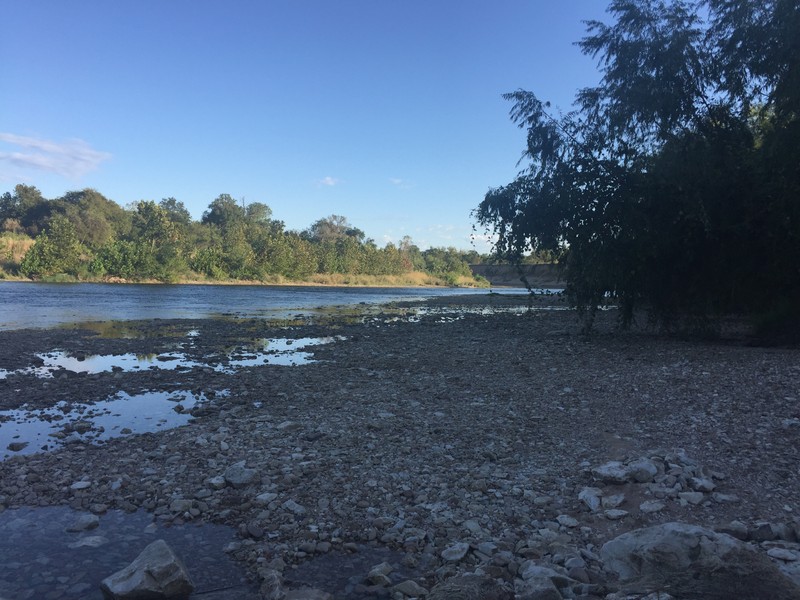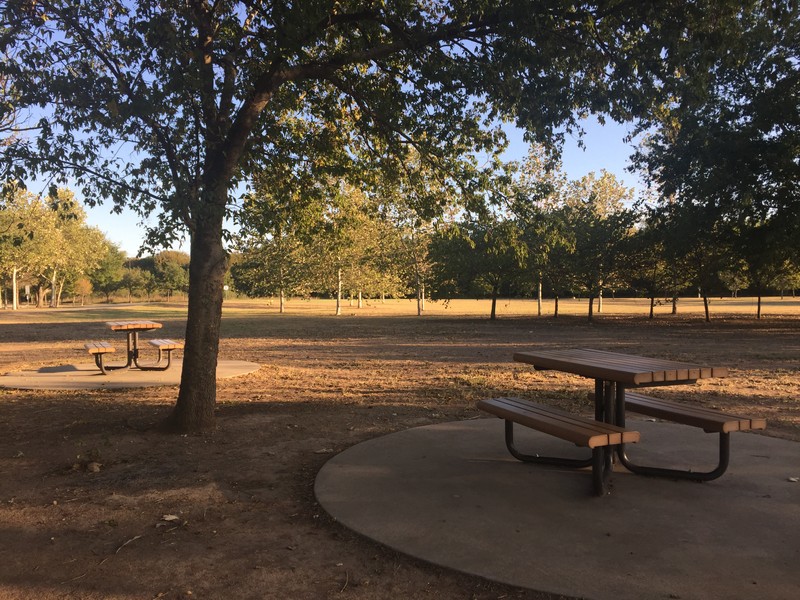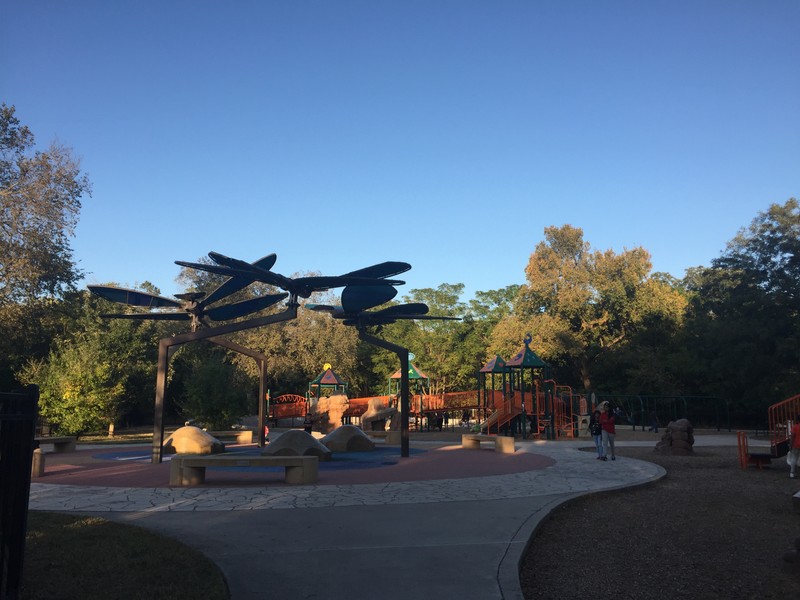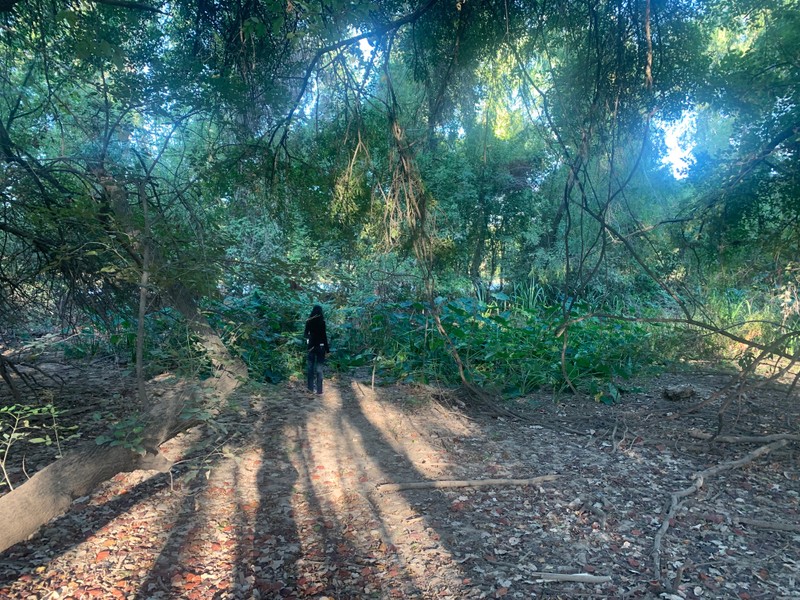Roy G. Guerrero Colorado River Metro Park
Introduction
Text-to-speech Audio
Images
The Colorado River Access Point

Picnic area on The Great Lawn

Children's Adventure Play Area


Overgrown and wild



Backstory and Context
Text-to-speech Audio
THE IMPACT OF ROY G. GUERRERO PARK
Roy G. Guerrero Park is the product of both community and metropolitan involvement. Between 1958 and 1994, the park underwent gradual development as pieces of it were slowly assembled to create the local attraction that is appreciated by Austin’s residents today. Progress met completion in 2000, and the finalized arrangement was the result of immeasurable amounts of dollars and the participation of the Resolution Trust Corporation, the Trust for Public Land, the Austin Parks Foundation, Hargreaves Associates, the Austin Parks and Recreation Department, and the Texas Recreation and Park Society.
LAND ACQUISITION
Initially known as Colorado River Park, the first segment was acquired in 1958 and consisted of 63 acres, a section that occupied areas alongside Pleasant Valley Road. Between 1958 and 1986, Austin Parks and Recreation had accumulated a substantial amount of resources and donations from the city and supporters of the park which included $6.4 million in bond authorizations, and 77 acres to fulfill intentions of expansion bordering the Colorado River. Along with the procurements, however, the park was forced to confront issues of project failure, particularly the College Park subdivision. The property endured the Savings and Loans crisis of the 1980s with the assistance of the Resolution Trust Corporation, a financial management company that was established to liquidate the assets of institutions affected by the monetary debacle. The subdivision was later purchased from the RTC by the Trust for Public Land, an organization motivated by the idea of maintaining living conditions in which generations could thrive. Its endeavors revolved around the preservation of land through developments (specifically parks), which inspire people to act on their appreciation of the natural beauty of the environment around them. The subdivision became a component in a transaction between the Trust and the City of Austin in 1993.In 1992, there were pieces of land allocated for the Montopolis Youth Complex. 1 However, the infrastructures to support the complex’s recreational activities were actually not established until 2000. 2
LAND AND PARK DESIGN
In 1996, a select group of individuals became responsible for the proposal of the park’s final design, which included both its visionary outlook and an assessment of its overall cost. It was a matter of turning acreage, that previously served as an agricultural allotment and a site for the homeless, into a treasure for the community. In accordance with the plan, the projection amounted to $50 million, a number that would increase in the years to come to accommodate all of the details. The following year brought two significant acquisitions - a transaction with the Trust for Public Land that granted complete ownership of Colorado River Park and an additional 223 acres of property. One additional bond and $10 million later, Phase I of the park was completed in 1998. To build upon this success, the Austin Parks Foundation pursued further development with the assistance of California’s Hargreaves Associates. Still in effect today, the Foundation endorsed opportunities to publicly acknowledge the value of the environment through developments of community-oriented settings. Hargreaves Associates, a firm that specializes in landscape architecture, assisted in creating a Master Plan, which required additional expenses totaling $100,000. After receiving supplementary private donations, the Hargreaves finalized the park’s finishing touches in 2000. 3
RENAMING PARK
The park was previously known as Colorado River Park before it was renamed in August 2001 in honor of Roy G. Guerrero, a highly-respected representative of Austin Parks and Recreation. Widely praised within his community, Guerrero integrated Little League baseball games and was an advocate for Latino citizens. From boxing matches to social affairs, Guerrero consistently worked to create public spaces and facilities for the community of East Austin, which was mostly composed of minority communities. 4
THE DAMAGE DONE
On Memorial Day in 2015, due to heavy precipitation, severe flooding overwhelmed the supporting structures beneath the concrete bridge within the park at Country Club Creek. The bridge unites the Ann and Roy Butler Hike-and-Bike trail with other recreational spaces located in the eastern section of Guerrero Park. The channel was constructed years earlier to redirect floodwaters from the Country Club Creek to the Colorado River and allow for more developments on Riverside Drive. Following the setback, erosion has been affecting areas within and surrounding the park which has increased the difficulty of building another bridge because any structures within the channel may fail due to lack of stability. 5 This destructive event increased awareness of the problem, and in 2017 an interim project was introduced to slow down the harmful effects of erosion within the park. As time progresses, Roy G. Guerrero Park has begun to thrive due to the location and treatment of the park in the past decade. 6 Precourt Sports Ventures considered building a major league soccer stadium in the park, a project that was later rejected. Many people came out to protest the stadium possibly being built in Roy G. Guerrero Park. Locals saying that it should be a place for the community, not tourism. 7
Sources
1 East Riverside/Oltorf Combined Neighborhood Plan, AustinTexas.gov - the official website of the City of Austin. Accessed October 10th 2019. http://www.austintexas.gov/edims/document.cfm?id=99375.
2 Oko, Dan. "Naked City: A River Runs Through It." The Austin Chronicle (Austin) January 28th 2000.
3 East Riverside/Oltorf Combined Neighborhood Plan.
4 Barnes, Michael. "Make sure Roy Guerrero is not remembered just as a park." Statesman (Austin) December 7th 2018.
5 Roy G. Guerrero Park Channel Stabilization, Watershed Protection Department. Accessed October 28th 2019. https://www.austintexas.gov/countryclubcreek.
6 Pritchard, Caleb . Creek project creates long delay for bridge replacement in Southeast Austin, Austin Monitor. June 15th 2017. Accessed October 28th 2019. https://www.austinmonitor.com/stories/2017/06/creek-project-creates-long-delay-bridge-replacement-southeast-austin/.
7 Bils, Chris. Austin's Guerrero Park becomes latest focus of MLS stadium search, Statesman. September 22nd 2018. Accessed October 30th 2019. https://www.statesman.com/sports/20180207/austins-guerrero-park-becomes-latest-focus-of-mls-stadium-search.
Additional Sources:
Bell, Jeff. De Leon, Luis. Knight, Drew. Woman reportedly attacked at Guerrero Park, police seeking a suspect, KVUE abc. July 19th 2019. Accessed October 20th 2019. https://www.kvue.com/article/news/crime/woman-reportedly-attacked-at-guerrero-park-police-seeking-a-suspect/269-bbf441a4-81eb-4708-a77c-11bad53ad934.
Devenyns, Jessi. FEMA grants Austin funding to help fix Guerrero Park, Austin Monitor. February 26th 2018. Accessed October 30th 2019. https://www.austinmonitor.com/stories/2018/02/fema-grants-austin-funding-help-fix-guerrero-park/.
Discovering the Colorado - A Vision for the Austin-Bastrop River Corridor, AustinTexas.gov - The Official Website of the City of Austin. December 2006. Accessed October 18th 2019. https://www.austintexas.gov/sites/default/files/files/Water/CER/coloradofinal2.pdf.
Pagano, Elizabeth. The Secret's Out, The Austin Chronicle. October 25th 2013. Accessed November 20th 2019. https://www.austinchronicle.com/news/2013-10-25/the-secrets-out/.
Prothro, Rowan & Carter, Casey. Roy G. Guerrero Colorado River Metropolitan Park, Central Texas Naturalist Places to Explore. Accessed October 30th 2019. https://txmn.org/centralplaces/roy-g-guerrero-colorado-river-metropolitan-park/.
Reid, Pete. MLS to ATX #6: The Roy G. Guerrero Colorado River Park and The Austin Swing, Austin Sports Law Blog. February 2nd 2018. Accessed October 28th 2019. http://austin-sports-law.com/mls-to-atx-6-the-roy-g-guerrero-colorado-river-park-and-the-austin-swing/.
Resolution Trust Corporation, Federal Register - The Daily Journal of the United States Government. Accessed October 23rd 2019. https://www.federalregister.gov/agencies/resolution-trust-corporation.
Roy G. Guerrero Colorado River Metro Park, Austin Parks Foundation. October 13th 2019. Accessed October 28th 2019. https://austinparks.org/roy-g-guerrero-metro-park/.
Roy G. Guerrero Colorado River Park Channel and Bridge Repairs, Austin Parks & Recreation. Accessed October 28th 2019. http://www.austintexas.gov/department/roy-g-guerrero-colorado-river-park-channel-and-bridge-repairs.
Toney, S. M. (1995, August). The Texas state parks system: an administrative history, 1923-1984. Texas Tech University.
Tolbert, H. A. (1965, August). Texas history: a resource for state parks. Texas Tech University.
The Trust for Public Land. Accessed November 19th 2019. https://www.tpl.org.
